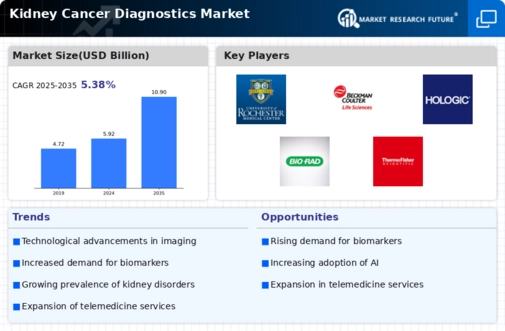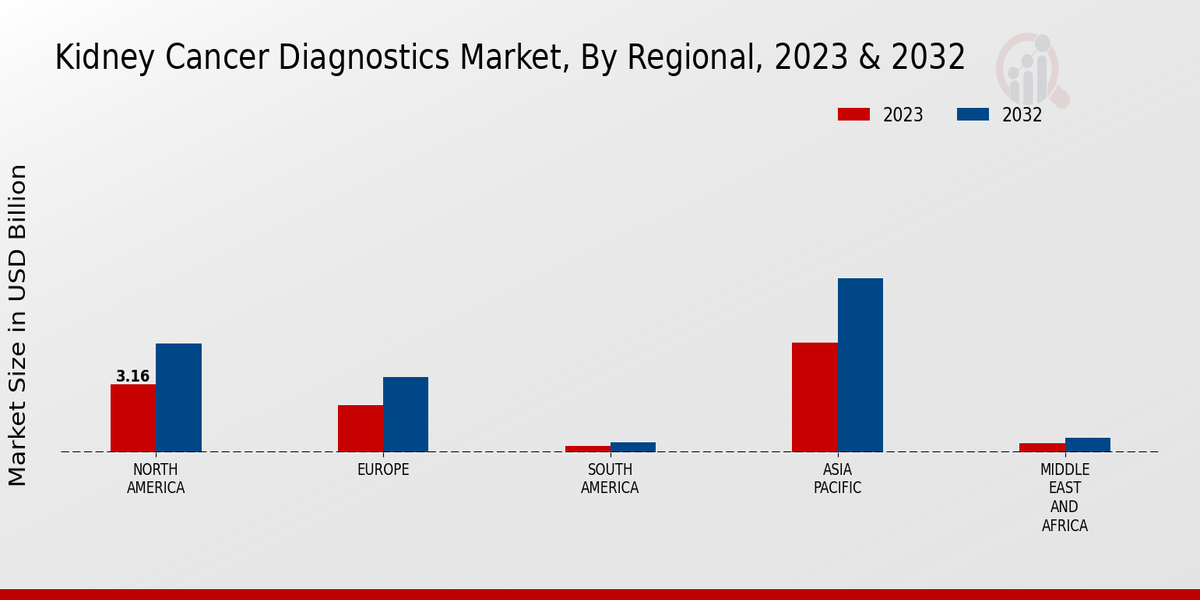Market Growth Projections
The Global Kidney Cancer Diagnostics Market Industry is projected to experience substantial growth over the next decade. With a market valuation of 5.92 USD Billion anticipated in 2024, the industry is expected to expand significantly, reaching an estimated 10.9 USD Billion by 2035. This growth trajectory reflects a compound annual growth rate (CAGR) of 5.72% from 2025 to 2035. Factors contributing to this growth include rising incidence rates, technological advancements, and increased awareness of kidney cancer. As the market evolves, it is likely to attract further investment and innovation, positioning it as a critical area within the broader healthcare landscape.
Rising Incidence of Kidney Cancer
The Global Kidney Cancer Diagnostics Market Industry is experiencing growth due to the increasing incidence of kidney cancer worldwide. According to credible health statistics, kidney cancer cases are projected to rise, with an estimated 76,000 new cases diagnosed in the United States in 2024 alone. This surge in cases necessitates advanced diagnostic tools and technologies, thereby driving demand within the market. As awareness of kidney cancer symptoms improves, more individuals seek diagnostic services, further contributing to market expansion. The anticipated growth in the number of cases is expected to propel the Global Kidney Cancer Diagnostics Market to a valuation of 5.92 USD Billion in 2024.
Investment in Research and Development
Investment in research and development is a key driver of the Global Kidney Cancer Diagnostics Market Industry. Increased funding from both public and private sectors is facilitating the exploration of novel diagnostic methods and technologies. This investment is crucial for advancing understanding of kidney cancer biology and improving diagnostic accuracy. For instance, ongoing research into biomarkers for kidney cancer is expected to yield new diagnostic tests that could revolutionize early detection. As R&D efforts continue to expand, they are likely to enhance the market's growth potential, aligning with the projected CAGR of 5.72% from 2025 to 2035.
Growing Awareness and Screening Programs
Increased awareness regarding kidney cancer and the importance of early detection is a significant driver for the Global Kidney Cancer Diagnostics Market Industry. Public health campaigns and screening programs are being implemented globally to educate individuals about risk factors and symptoms associated with kidney cancer. These initiatives encourage regular health check-ups and screenings, leading to earlier diagnosis and treatment. For example, countries with robust screening programs have reported higher survival rates. As awareness continues to grow, the demand for diagnostic services is expected to rise, further propelling the market's growth trajectory.
Aging Population and Associated Health Risks
The aging population is a crucial factor influencing the Global Kidney Cancer Diagnostics Market Industry. As individuals age, the risk of developing kidney cancer increases, leading to a higher demand for diagnostic services. With the global population aged 65 and older projected to reach 1.5 billion by 2030, the implications for kidney cancer diagnostics are profound. This demographic shift necessitates enhanced screening and diagnostic capabilities to address the rising incidence of kidney cancer among older adults. Consequently, the market is poised for growth, driven by the need for effective diagnostic solutions tailored to this vulnerable population.
Technological Advancements in Diagnostic Tools
Technological innovations play a pivotal role in shaping the Global Kidney Cancer Diagnostics Market Industry. The development of advanced imaging techniques, such as MRI and CT scans, alongside the introduction of liquid biopsy methods, enhances the accuracy and efficiency of kidney cancer detection. These advancements not only facilitate early diagnosis but also improve patient outcomes. For instance, the integration of artificial intelligence in imaging analysis is expected to streamline diagnostic processes. As these technologies become more accessible and affordable, they are likely to drive market growth, contributing to a projected market size of 10.9 USD Billion by 2035.







